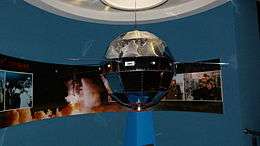Dong Fang Hong I
Dongfanghong I (simplified Chinese: 东方红一号; traditional Chinese: 東方紅一號; pinyin: Dōngfānghóng Yīhào; lit.: 'The East is Red 1') was the first space satellite of the People's Republic of China (PRC), launched successfully on 24 April 1970 as part of the PRC's Dongfanghong space satellite program. It was a part of the "Two Bombs, One Satellite" program. At 173 kg (381 lb), it was heavier than the first satellites of other countries. The satellite carried a radio transmitter which broadcast the de facto national anthem of the same name. The broadcast lasted for 20 days while in orbit.
 DFH-1 model | |
| Mission type | Technology |
|---|---|
| Operator | CAST |
| COSPAR ID | 1970-034A |
| SATCAT no. | 4382 |
| Mission duration | 20 days |
| Spacecraft properties | |
| Launch mass | 173.0 kilograms (381.4 lb)[1] |
| Start of mission | |
| Launch date | 24 April 1970, 13:35:45 UTC[2] |
| Rocket | Chang Zheng 1 |
| Launch site | Jiuquan LA-2 |
| End of mission | |
| Last contact | 14 May 1970 |
| Orbital parameters | |
| Reference system | Geocentric |
| Regime | Medium Earth |
| Semi-major axis | 7,615.66 kilometres (4,732.15 mi)[3] |
| Eccentricity | 0.1053251[3] |
| Perigee altitude | 442 kilometres (275 mi)[3] |
| Apogee altitude | 2,046 kilometres (1,271 mi)[3] |
| Inclination | 68.42 degrees[3] |
| Period | 110.24 minutes[3] |
| RAAN | 199.11 degrees[3] |
| Argument of perigee | 98.23 degrees[3] |
| Mean anomaly | 13.06 degrees[3] |
| Mean motion | 13.06[3] |
| Epoch | 24 January 2015, 01:39:49 UTC[3] |
| Revolution no. | 10,099[3] |
It was developed under the direction of Qian Xuesen (Tsien Hsue-shen), dean of the Chinese Academy of Space Technology (CAST). At the time, a total of five identical satellites were created. The first satellite launched successfully. The academy formulated a "Three-Satellite Plan" consisting of Dongfanghong I, re-entry satellites, and geosynchronous orbit communications satellites. Sun Jiadong was responsible for the Dongfanghong I technology. In 1967, Dang Hongxin chose a copper antenna membrane that resolved the difficulties of broadcasting on an ultra-short wave antenna between 100 °C and −100 °C. Engineers installed a music player playing "The East is Red" on the satellite.
Launch
While Dongfanghong I was transported to the launch site by train, armed guards were placed between every two electricity poles. On 24 April 1970 at 9:35 pm, a Long March I rocket (CZ-1) lifted off from the Jiuquan Satellite Launch Center, placing the Dongfanghong I satellite in orbit at 9:48 pm.
Objectives
The primary purpose of the Dongfanghong I satellite was to perform tests of satellite technology and take readings of the ionosphere and atmosphere.
Satellite design
The satellite was similar in shape to a symmetrical 72-faced polyhedron, had a mass of 173 kg (381 lb), and had a diameter of approximately one meter (39 in). It spun 120 times per minute for stabilization. The outer surface was coated with a processed aluminum alloy for temperature control. The main body of the sphere had four ultrashortwave whip antennas of at least two meters (6½ ft) in length. The lower section was connected to a stage containing a rocket motor. It had a shiny metallic ring added to the bottom, with brightness magnitude from +5 to +8.
Orbit
The satellite remains in orbit; as of 24 January 2015 it was in an orbit with a perigee of 442 kilometres (275 mi), an apogee of 2,046 kilometres (1,271 mi) and inclination of 68.42 degrees.[3] This near-earth elliptical orbit was 114.09 minutes per orbit. It has Satellite Catalog Number 4382 and International Designator 1970-034A.[4]
Dongfanghong I had a design life of 20 days. During that time, it transmitted telemetry data and space readings to the Earth. On 14 May, its signal stopped.
Reaction
With the successful launch of Dongfanghong I, China became the fifth country after the Soviet Union, United States, France, and Japan to independently launch a satellite. Although Dongfanghong I was launched 13 years after Sputnik I, its mass exceeded the combined masses of the first satellites of the other four countries. After this launch, Qian Xuesen proposed to the Chinese government that China should develop a manned space program and submitted a manned space undertaking report. Mao Zedong himself signed "approved" to the report.
On 21 April 2005, the Chinese Academy of Space Technology gathered the science and technology personnel who participated in the design, manufacture, production, and supervision of Dongfanghong I. The birthplace of Dongfanghong I, the Beijing Satellite Manufacturing Plant, was used as a monument. The manufacturing plant, in coordination with the Shenzhou 5 manned spacecraft anniversary, created a 1:1 scale replica of the Dongfanghong I satellite. It was exhibited in the Beijing Planetarium.
See also
References
- "PRC 1". National Space Science Data Center. Retrieved 13 December 2013.
- McDowell, Jonathan. "Launch Log". Jonathan's Space Page. Retrieved 13 December 2013.
- "DFH-1 Satellite details 1970-034A NORAD 4382". N2YO. 24 January 2015. Retrieved 25 January 2015.
- McDowell, Jonathan. "Satellite Catalog". Jonathan's Space Page. Retrieved 13 December 2013.